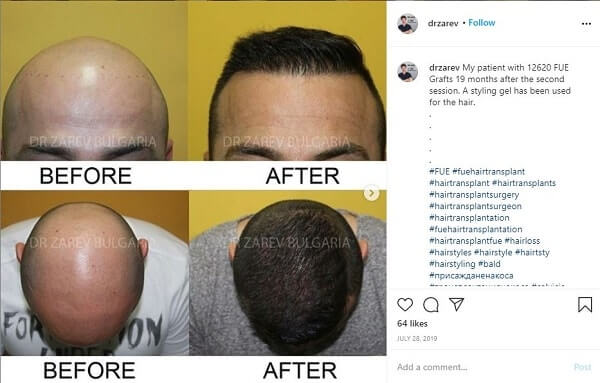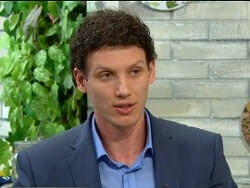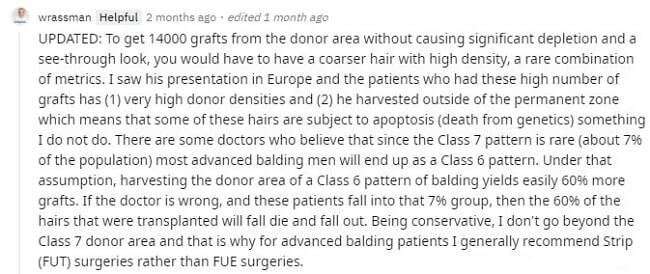
In general, I avoid writing an entire blog post on any individual hair transplant surgeon. I make rare exceptions to this rule when a surgeon is doing something groundbreaking, or garnering a lot of online attention.
My main reason for limiting these types of posts is due to the fact that even the most gifted hair transplant surgeons will have some bad results and unsatisfied patients. I never want to encourage a reader to go to someone specific for a hair restoration procedure just based on one blog post. You have to always do your own extensive research (both online and offline) before making a choice.
Moreover, some surgeons are mostly interested in publicity and marketing. I could be unwillingly helping them by overestimating their abilities in a post. By corollary, I could also be judging someone too harshly or even entirely ignoring them unjustifiably. I have never had a hair transplant, so such posts are never first-person accounts.
In any event, I can no longer ignore Dr. Tsvetelin Zarev from Bulgaria (his first name is also spelled as “Tsvetalin” on the web). I communicated with him several times during the past year (see his responses further below in this post). I was still not too keen in writing about him without getting more feedback from other surgeons.
However, during the past month, a number of readers have inquired about his gigasession (or giga session) hair transplant procedure. This is likely due to this 2-month old Reddit post followed by this large recent HLT thread. So I have decided to finally write about Dr. Zarev.
I am also writing this post in order to warn readers about the dangers of falling for marketing terms such as FUE megasessions, FUE gigasessions and even “super gigasessions”. Please read the bottom of this post carefully.
Dr. Tsvetalin Zarev
I first heard about Dr. Zarev and his crazy up to 14,000 graft follicular unit extraction (FUE) gigasession hair transplants in 2019. At the time, the highly experienced Dr. John Cole praised Dr. Zarev profusely at the 8th Annual FUE Europe Conference. See Dr. Zarev’s presentation from that conference here (video also embedded below).
He has apparently developed a new extraction technique via which he can extract 60 percent of hair from the donor area, without leaving any obvious signs of damage or barren gaps. Note that for some androgenetic alopecia (male pattern baldness) sufferers, even the “permanent” donor region can thin significantly in old age. So look at your family history of baldness progression before choosing to undergo any large procedure that you might regret later.
10,000 Grafts More Common
Later on, while browsing through Dr. Zarev’s Instagram, it became clear that most of his patients seem to get closer to 10,000 grafts (spread across two or three procedures). Same when it comes to Dr. Zarev’s Facebook page. I saw a few cases of patients getting 10,000-12,500 grafts across two procedures. The 14,000 graft cases are likely extremely rare.
This is a relief, as it shows that Dr. Zarev is not just performing “super gigasession” hair transplants willy nilly just to break world records. There was a time when even 4,000 graft FUE procedures were considered to be too large, but it seems like this is no longer the case?
Note that an average graft has 2-3 hair follicles. And there are around 90,000-150,000 hair follicles on an average human head.
While I enjoyed the above presentation by Dr. Zarev, I did not pay too much heed to Dr. Cole’s praise. For one, I have not heard of too many other ISHRS member surgeons singing Dr. Zarev’s praise as yet. Moreover, Dr. Cole has over the years praised many people and procedures. Including exosomes and a Turkish hair transplant surgeon just this year.

Dr. Zarev seems extremely young to me based on the earlier mentioned 2019 video. However, it turns out that he has already been performing hair transplants for 10 years! Here is a local Bulgarian video from 2014 that covers Dr. Zarev.
His IAHRS profile mentions that he uses both manual and motorized FUE techniques, and applies a vacuum assisted technique for hair transplantation.
Dr. Zarev’s FUE price is 4 Euros per graft. See my hair transplant cost table for comparisons. I am surprised that there are no Google reviews of Dr. Zarev’s clinic as yet. Or perhaps in the US I am not being shown the Bulgarian version of Google reviews?
Dr. Zarev’s Email Response
I e-mailed Dr. earlier this year, and it took him a month to reply. I then e-mailed him again in May, and he replied again in July. Normally, one would get annoyed at this kind of cat and mouse waiting game. However, I was pleased to see that he is not in any way desperate or even keen for my covering him on this blog. Some hair transplant surgeons and/or their representatives have in the past bugged me incessantly to write about them and their latest groundbreaking technique.
These were my questions for Dr. Zarev:
1) If there is still controversy about FUE megasessions (and dense packing), how did you mange to go one step above into FUE gigasessions without attracting controversy? What percent of follicles can get damaged during gigasession dense packing?
2) How many grafts would you define as being in a) A typical average hair transplant. b) A megasession. c) A gigasession.
3) Are other surgeons such as Dr. Cole who praised you now offering this same procedure?
4) Can you also do strip/FUT gigasessions?
This was his response after 1.5 months:
1) I created FUE technology (My Note: I think he means his version of existing FUE), which in most cases allows me to extract up to 60% of the donor areas without causing unaesthetic dilution. The density of implantation in the recipient areas is a very important value, which is calculated individually for each patient, according to many parameters – diameter of the follicular units, number of follicles in the follicular units, length of the follicular units, elasticity of the sclera in the recipient areas, thickness , the dermis and subdermis, the specifics of the anatomy of the blood supply of the recipient areas, the location of the recipient areas and many others. Gigasessions do not necessarily mean a high density of transplants. When needed, I usually do it in two surgeries every 10 months.
2) Not categorized operations of small, medium and large. I transplant as much as necessary to achieve a natural visual density. I have had operations under 100 grafts, as well as over 14,000.
3) At this stage I have not shared this technology with anyone as I am still in development.
4) The type of operation I perform makes the application of FUT completely meaningless. (My Note: See my post on FUE versus FUT hair transplants).
Clarification
Dr. Zarev sent me the following update after reading this post:
“I have never sought out loud popularity through the operations I perform classified as FUE Super Giga Sessions. Such operations are only part of my practice. I would also like to clarify that the self-serving, ill-considered and unjustified pursuit of operations with such a volume can be extremely dangerous and harm patients irreversibly. For the past few months, I have received daily inquiries from patients wishing for such an operation. For most of them, even from the low-quality photos they send, it is clear that they do not have enough resources in donor areas for an operation of this size.
The planning of operations with such a volume can be done only through personal consultation and precise and in-depth analysis of the donor and recipient areas. It is also extremely important to predict future losses, in cases where the baldness process is still in progress. I hope that the results I am showing do not give rise to vain hopes in many patients from which unscrupulous practices will take advantage of. Such scenarios can only lead to a lot of frustration. The operations I have performed in excess of 10,000 grafts are a result of in-depth preliminary analysis, meticulous execution and of course extraction technology, outside the general standards.
At the upcoming GHLS 2020 virtual conference, I will show a detailed video of one of my two-day operations. The video shows all stages of a patient’s first operation, in which the surgical plan includes the transplantation of a total of 11,500 grafts. And I want to clarify that in my practice, nurses do not have direct contact with the patient during the operation. I always perform personally all manipulations on the scalp, both in the process of extraction and in the process of implantation.”
Megasession versus Gigasession Marketing
If you Google search for “FUE gigasession” or “FUE giga session”, you will find an increasing number of surgeons claiming to offer such procedures. It has become a marketing gimmick. Some patients are even led to believe that a 10,000 plus graft procedure can be performed in one sitting with no risk. This is really dangerous. Make sure to read my posts on hair transplant gone wrong and on the dangers of getting a hair transplant abroad.
Two common problems with large giga session or even mega session type hair transplant procedures are:
- The donor region becomes see through and very thin and strange looking. Some call this look “moth eaten”.
- The surgeon overpromises and overcounts grafts. There are no shortages of cases where hair transplant patients receive fewer grafts than what they paid for. All the more reason to go to ethical and respected surgeons, even if significantly more expensive.
Dr. Alan Feller has in the past discussed the difficulties in even performing quality 2,500 or 4,000 graft mega sessions. Dr. Zarev seems to regularly be performing 6,000 graft procedures in one sitting. I assume it is much cheaper to hire technicians in Bulgaria versus in the US (Edit: seems like the doctor does all the “direct contact” work himself). But this many grafts is still crazy. Hopefully, Dr. Zarev can in the future share more information about his new vacuum assisted graft extraction technique.
On Reddit, Dr. William Rassman offered the following important warning on super giga session type procedures:
